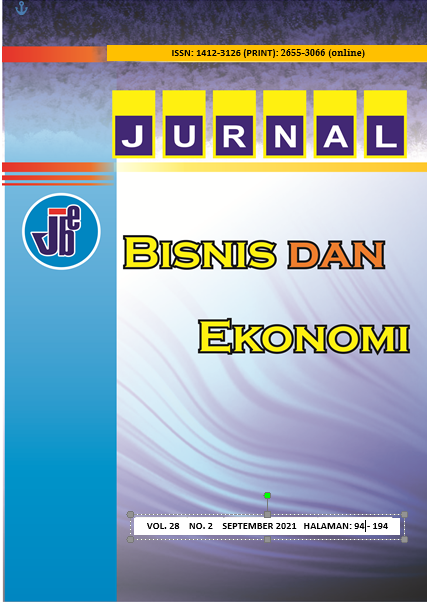Apakah Kesenangan dan Romantisme Menimbulkan Cinta Merek?
Abstract
This study aims to examine Customer Delight, romanticism towards brand love of body care products. This study uses quantitative methods. The sample in this study were users of body care products in the city of Semarang. Data was collected using an online questionnaire through a goggle form which was distributed to 150 respondents for one month. Data analysis used regression analysis from SPSS. The results show that Customer Delight, romanticism has a positive effect on brand love of body care products.
References
Ahuvia, A., Rauschnabel, P. A., & Rindfleisch, A. (2020). Is brand love materialistic? Journal of Product and Brand Management, 30(3), 467–480. https://doi.org/10.1108/JPBM-09-2019-2566
Albert, N., & Merunka, D. (2013). The role of brand love in consumer-brand relationships. Journal of Consumer Marketing, 30(3), 258–266. https://doi.org/10.1108/07363761311328928
Ali, W., Qadir, I., Khuhro, R. A., & Qureshi, Q. A. (2017). Determinants of Brand Loyalty among Late Movers of Motorbike Industry in District Haripur, Pakistan: A Brand Romance Perspective. University of Haripur Journal of Management (UOHJM), 2(1), 133–144. https://www.proquest.com/scholarly-journals/determinants-brand-loyalty-among-late-movers/docview/2173870250/se-2?accountid=39807
Bagozzi, R. P., Batra, R., & Ahuvia, A. (2017). Brand love: development and validation of a practical scale. Marketing Letters, 28(1), 1–14. https://doi.org/10.1007/s11002-016-9406-1
Bagozzi, R. P., & Yi, Y. (2012). Specification, evaluation, and interpretation of structural equation models. Journal of the Academy of Marketing Science, 40(1), 8–34. https://doi.org/10.1007/s11747-011-0278-x
Bairrada, C. M., Coelho, F., & Coelho, A. (2018). Antecedents and outcomes of brand love: utilitarian and symbolic brand qualities. European Journal of Marketing, 52(3–4), 656–682. https://doi.org/10.1108/EJM-02-2016-0081
Barnes, D. C., & Krallman, A. (2019). Customer Delight: A Review and Agenda for Research. Journal of Marketing Theory and Practice, 27(2), 174–195. https://doi.org/10.1080/10696679.2019.1577686
Batra, R., Ahuvia, A., & Bagozzi, R. P. (2012). Brand love. Journal of Marketing, 76(2), 1–16. https://doi.org/10.1509/jm.09.0339
Bıçakcıoğlu, N., İpek, İ., & Bayraktaroğlu, G. (2018). Antecedents and outcomes of brand love: the mediating role of brand loyalty. Journal of Marketing Communications, 24(8), 863–877. https://doi.org/10.1080/13527266.2016.1244108
Breivik, E., & Thorbjørnsen, H. (2008). Consumer brand relationships : an investigation of two alternative models. 443–472. https://doi.org/10.1007/s11747-008-0115-z
Carroll, B. A., & Ahuvia, A. C. (2006). Some antecedents and outcomes of brand love. Marketing Letters, 17(2), 79–89. https://doi.org/10.1007/s11002-006-4219-2
Dey, S., Ghosh, S., Datta, B., & Barai, P. (2017). A study on the antecedents and consequences of customer delight. Total Quality Management and Business Excellence, 28(1–2), 47–61. https://doi.org/10.1080/14783363.2015.1049146
Kim, M. R., Vogt, C. A., & Knutson, B. J. (2015). Relationships Among Customer Satisfaction, Delight, and Loyalty in the Hospitality Industry. Journal of Hospitality and Tourism Research, 39(2), 170–197. https://doi.org/10.1177/1096348012471376
Kwong, K. K., & Yau, O. H. M. (2002). The Conceptualization of Customer Delight : A Research Framework. Asia Pacific Management Review, 7(October 2001), 255–266.
Mano, H., & Ollver, R. L. (2015). December 1993 AU rights reserved. 20(December 1993), 451–466. http://jcr.oxfordjournals.org/
Manthiou, A., Kang, J., Hyun, S. S., & Fu, X. X. (2018). The impact of brand authenticity on building brand love: An investigation of impression in memory and lifestyle-congruence. International Journal of Hospitality Management, 75(March 2017), 38–47. https://doi.org/10.1016/j.ijhm.2018.03.005
Patwardhan, H., & Balasubramanian, S. K. (2011). Brand romance: A complementary approach to explain emotional attachment toward brands. Journal of Product and Brand Management, 20(4), 297–308. https://doi.org/10.1108/10610421111148315
Putra, H. B., Pradita, N., & Hayuningtias, K. A. (2020). Prediksi Niat Penggunaan Aplikasi Dan Permainan Daring Freemium Versi Berbayar Dengan Menggunakan Model Tpb. Managament Insight: Jurnal Ilmiah Manajemen, 15(2), 130–143. https://doi.org/10.33369/insight.15.2.130-143
Putra, H. B., Pradita, N., & Mansyur, A. (2022). Integration Model Tpb and Perceived Risk of Intention of Use Applications and Games Online Freemium Paid Version: Indonesian Students Context. Inovbiz: Jurnal Inovasi Bisnis, 9(2), 110. https://doi.org/10.35314/inovbiz.v9i2.1999
Rageh Ismail, A., & Spinelli, G. (2012). Effects of brand love, personality and image on word of mouth: The case of fashion brands among young consumers. Journal of Fashion Marketing and Management: An International Journal, 16(4), 386–398. https://doi.org/10.1108/13612021211265791
Roy, S. K., Eshghi, A., & Sarkar, A. (2013). Antecedents and consequences of brand love. Journal of Brand Management, 20(4), 325–332. https://doi.org/10.1057/bm.2012.24
Sarkar, A. (2011). Romancing With A Brand: A Conceptual Analysis Of Romantic Consumer-Brand Relationship. Management & Marketing, 6(1), 79–94. http://econpapers.repec.org/article/ephjournl/v_3a6_3ay_3a2011_3ai_3a1_3an_3a5.htm











